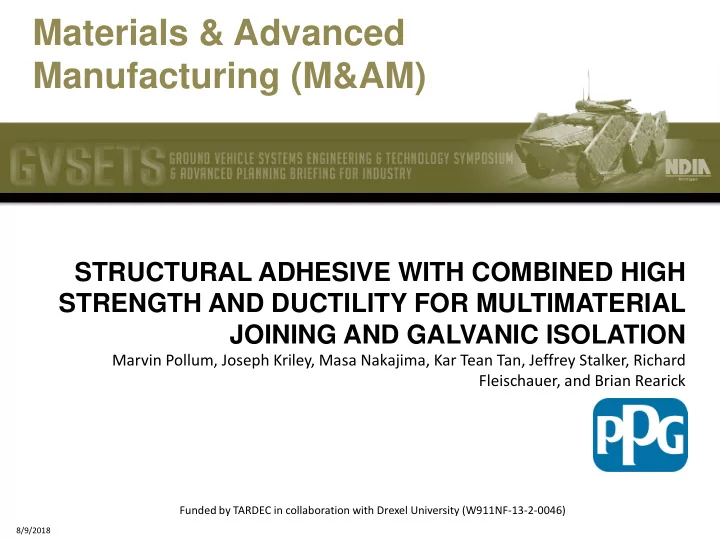

Materials & Advanced Manufacturing (M&AM) STRUCTURAL ADHESIVE WITH COMBINED HIGH STRENGTH AND DUCTILITY FOR MULTIMATERIAL JOINING AND GALVANIC ISOLATION Marvin Pollum, Joseph Kriley, Masa Nakajima, Kar Tean Tan, Jeffrey Stalker, Richard Fleischauer, and Brian Rearick Funded by TARDEC in collaboration with Drexel University (W911NF-13-2-0046) 8/9/2018
Materials & Advanced Introduction Manufacturing (M&AM) • Significant lightweighting efforts in new vehicle designs • Implementation of dissimilar and non-metal materials requires: – High performance adhesives – Galvanic isolation http://tacticaldefensemedia.com/wp- content/uploads/2018/03/GVSETS-Sq-Ad-2.5.jpg 8/9/2018
Materials & Advanced Introduction Manufacturing (M&AM) • Researchers at ARL put forward new adhesive performance requirements based on screening hundreds of commercial adhesives Load 4” Bondline ½” 1” Load Thick 2024 ARL-SR-0371 Aluminum Substrate Group I properties correlate with greatest energy dissipation 8/9/2018
Materials & Advanced Adhesive Development Manufacturing (M&AM) • Recently developed structural adhesive with Group I performance Load 4” Bondline ½” 1” Load Thick 2024 Aluminum Substrate Combined higher strength (>6000 psi) and displacement (>35%) 8/9/2018
Materials & Advanced Adhesive Development Manufacturing (M&AM) • Recently developed structural adhesive with Group I performance − 1-component epoxy thermoset − 160°C cure temperature − Shelf-stable >9 months 1-component, shelf-stable, thermoset formulation 8/9/2018
Materials & Advanced Adhesive Development Manufacturing (M&AM) • High strength of adhesive causing thick Al substrate to deform Need to understand bulk material properties of adhesive 8/9/2018
Materials & Advanced Bulk Material Properties Manufacturing (M&AM) • Bulk shear properties measured independent of substrate • Thick Adherend Shear Test (ISO 11003-2) 8/9/2018
Materials & Advanced Bulk Material Properties Manufacturing (M&AM) • Increased shear stress with a significant increase in shear strain • Area under stress-strain curve = total strain energy density 2.5-fold increase in energy absorbed before failure 8/9/2018
Materials & Advanced Performance Validation Manufacturing (M&AM) • Group I performance verified by ARL R. Jensen et. al. 41 st Annual Meeting of The Adhesion Society. San Diego, CA. March 1, 2018. Does prototype adhesive hold up in extreme environments? 8/9/2018
Materials & Advanced Environmental Resistance Manufacturing (M&AM) • Tier II testing proposed by ARL, maintain 75% initial lap shear strength: Table 1. Retention of adhesive lap joint strength at elevated test temperature and following a variety of environmental conditionings. All tested on grit blasted AA2024 substrate. At elevated temperatures (71 o C) Lap Shear Strength Environmental Test After 2 week hot water immersion Strength Retention Conditioning Temp. (MPa) (%) None 25°C 43.0 ± 2.5 - • Also maintains high strength after None 71°C 35.4 ± 0.6 82.4 corrosive conditioning (salt spray) for 63°C water soak 25°C 33.5 ± 2.4 77.9 14 days 42 days, especially coated with Salt spray (bare) 25°C 29.1 ± 3.2 67.6 1000 hours primer Salt spray (primed) 82.3 25°C 35.4 ± 2.3 1000 hours Maintains strength in hot, wet, and corrosive environments 8/9/2018
Materials & Advanced Environmental Resistance Manufacturing (M&AM) • Thermoset epoxies typically lose performance at low temperatures • High strain rate wedge impact testing (ISO 11343) 25°C -40°C 25 Wedge Impact Energy (N/mm) 20 15 10 5 0 Prototype Structural Adhesive Maintains 67% of impact energy at -40 o C 8/9/2018
Materials & Advanced Environmental Resistance Manufacturing (M&AM) • Prototype Adhesive exhibits high strength and ductility while also maintaining performance under: High Humidity (100%) Elevated Temperatures (71°C) Low Temperatures (-40°C) Corrosive conditions (salt spray) • Environmental resistance also confirmed by ARL All tests performed on Al, what about other substrates? 8/9/2018
Materials & Advanced Other Substrates Manufacturing (M&AM) • Good adhesion even to galvanized steel (even oily) and to carbon fiber • However, substrate failure invalidates the lap joint measurements so these results are only qualitative Table 2. Performance of prototype adhesive on hot-dip galvanized steel (HDG), carbon fiber reinforced plastic (CFRP), and in mixed material joints. Lap Shear Displace- Failure Substrate Strength ment Mode (MPa) (mm) Oiled HDG 15.6 ± 0.4 15.8 ± 2.9 Adhesive Cleaned HDG 16.3 ± 0.2 40.8 ± 0.8 Substrate* CFRP 23.6 ± 1.9 5.2 ± 0.2 Substrate* Mixed 19.8 ± 1.5 3.1 ± 0.3 Substrate* AA2024/CFRP *Substrate failure invalidates the lap shear strength and displacement values, therefore these results are qualitative Preliminary qualitative results are promising 8/9/2018
Materials & Advanced Galvanic Isolation Manufacturing (M&AM) AA2024 CRS Carbon Fiber with adhesive without adhesive • Galvanic assemblies based on methods from NAVAIR and AMCOM • Combines carbon fiber, steel, and aluminum with fasteners and optionally adhesives Significantly reduced substrate corrosion by bonding/sealing with adhesive • Prototype formulation does not change adhesive’s ability to galvanically isolate 8/9/2018
Materials & Advanced Conclusions Manufacturing (M&AM) • Developed an adhesive meeting Group I specifications put forward by ARL • Extreme displacement of prototype adhesive due to high % strain of the bulk adhesive material • High strain energy density of adhesive also provides impact resistance • Formulations changes maintain adhesive’s resistance to extreme environments and ability to galvanically isolate mixed materials 8/9/2018
Materials & Advanced Acknowledgements Manufacturing (M&AM) • PPG Adhesives & Sealants Team • Rob Jensen and Dave Flanagan from ARL • Funding from TARDEC in collaboration with Drexel University (W911NF-13-2-0046) 8/9/2018
Recommend
More recommend